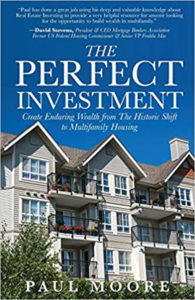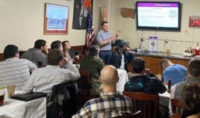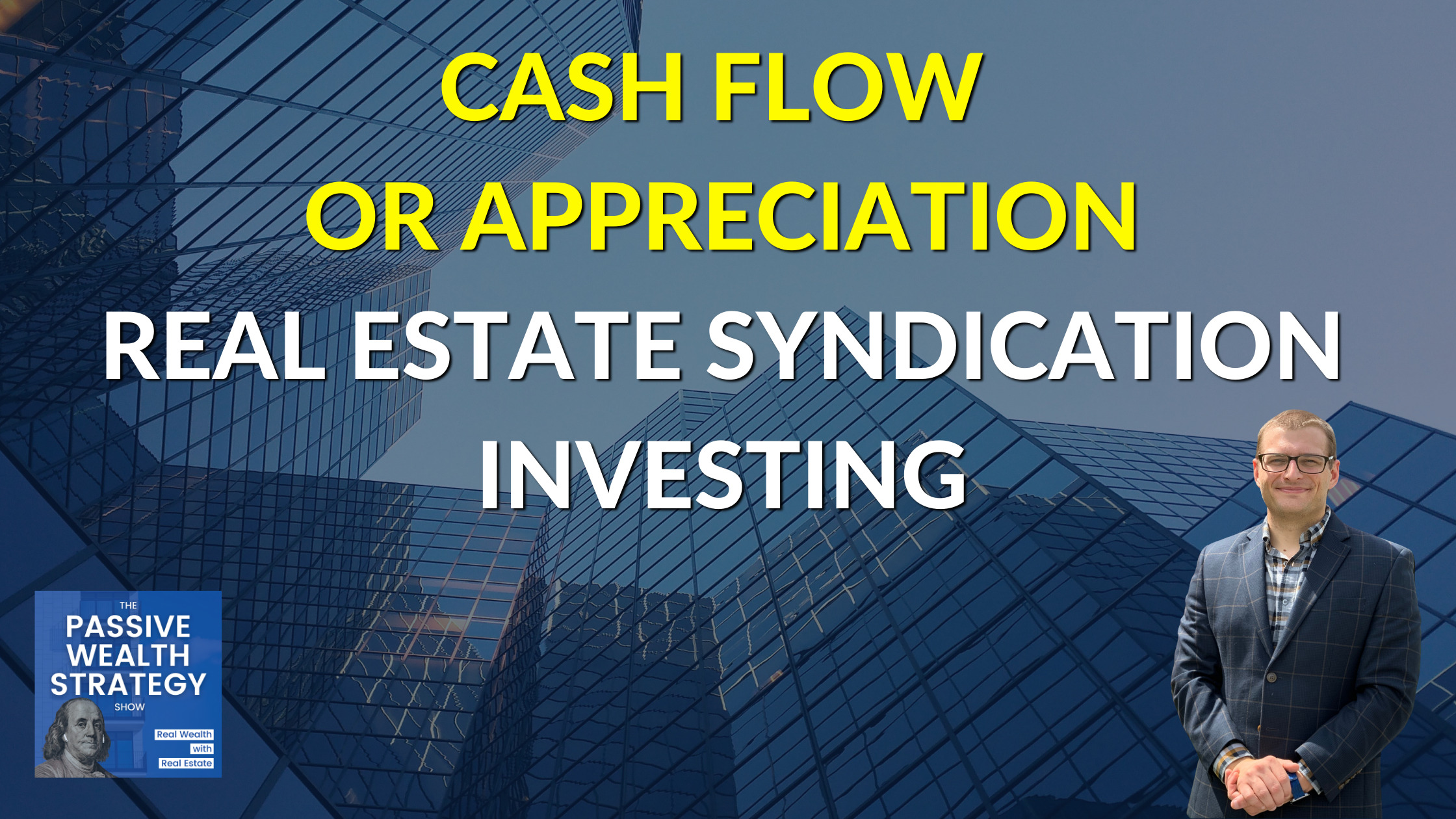Are you tired of losing money? Every investor’s dream is to find that stable, predictable, and high-return investment. Join Paul Moore in this episode and learn from his journey until he found the perfect investment. Paul is the owner of Wellings Capital where he helps busy professionals invest in real estate passively. He has an extensive background in real estate investing and entrepreneurship and is the co-host of the podcast called How To Lose Money and the author of The Perfect Investment. Find out how Paul got into real estate investing and found high-return investment in self-storage syndication.
—
The Secret to The Perfect Investment with Paul Moore
Our guest is Paul Moore. Paul is a prominent real estate investor, who owns a company called Wellings Capital where he helps busy professionals invest in real estate passively. He has an extensive background in real estate investing in entrepreneurship. He is the co-host of an awesome podcast called How To Lose Money. I’m a big fan of that podcast. You should definitely go look it up. Paul, welcome to the show.
Thanks, Taylor. It’s great to be here. I’m honored that you had me on the show.
I’m happy to have you on the show. I’m a big fan of your podcast. I’m definitely honored to be speaking with you. Tell our audience a little bit about your background and how you got to where you are now in real estate investing.
I got an engineering degree, which was my first mistake back in the early-mid ‘80s. I got an MBA, which landed me at Ford Motor Company on a management development track. I don’t think I was suited for a big company. Within a month of being there trying to figure out some side business to start, my buddy and I started an HR outsourcing company, basically an employee leasing staffing firm. We sold that company to a publicly traded firm. A lot of people in the FIRE movement are excited about retiring early. Being a high energy, Type A, entrepreneur and trying to semi-retire at 36 was foolish, especially since I had no plan. I tried to start a nonprofit organization. I thought I was investing. I was actually speculating along the way. The difference is if you’re investing, investing is when your principal is generally safe and you have a chance to make a return. Speculating is when your principal is generally at risk and you have a chance to make a return. I lost a lot of money along the way. I made some money too.
I started flipping houses. I got into flipping waterfront lots. I did a subdivision. I built some houses. I built a quasi-hotel, quasi-multifamily in North Dakota. I developed marketed man camps in North Dakota, which was quite profitable during the oil boom and residential real estate, which I still have a website that throws off leads to residential realtors every day. At some point I realized I’m in my 50s, I don’t want to lose money anymore. I decided to dial way down on my development type activities and wanted to do Class B value-add multifamily. I decided in my arrogance that that was the perfect investment, perfect risk-return type balance. I wrote a book with that name a couple of years ago called The Perfect Investment. That brings me to where I’m at now. I’ve got a couple of partners and we’re syndicating multifamily. Now we’re also syndicating self-storage deals.
If folks wanted to check out your book, where could they get a copy?
There comes a point when you get tired of losing money. Click To TweetThe Perfect Investment is available on Amazon and it’s also available at my website, WellingsCapital.com.
You syndicate multifamily, but now you’re syndicating self-storage. Can you tell us a little bit about that? Many of our audience will be familiar with syndication already, and for those that aren’t, we have episodes that are exclusively dedicated to the basics of syndication. If you don’t know the basics, I suggest you go back to those. For now, for everyone that has a basic understanding of what syndication is, why have you shifted asset classes nowadays?
You get tired of losing money. I didn’t want to be in a situation where I was in my 50s, 60s, 70s and couldn’t work anymore for whatever reason. I didn’t want to be on the downside of one of those investments gone bad. I had some of those certainly, and every entrepreneur I know has. I decided that I wanted to get into something that was safe, stable, reliable and had demographic trends that would allow me to look decades into the future and predict this is something that it’s going to be still viable. Warren Buffett said in general, he doesn’t invest in the internet because he wants to be in something that has more likelihood of where it will be in a couple of decades. He said, “The internet will never change the way people chew gum.” I thought about that. I thought of multifamily. I believe that the apartments that are being built and have been built the last several decades will still be in use in general, many years from now. People are always going to need apartments. They may look different. They may have a lot of different gadgets and features, but generally, apartments will still be around. I plowed into it and with my risk tolerance being so low, we have had a hard time finding deals that made sense for us and for our investors. We didn’t want to overpay. The problem is the market has been going up and up over the last several years.
In frustration, I turned and said, “I’m going to look at something else.” I found out something and that is that self-storage. There are 53,000 self-storage facilities in the US. That’s as many as Starbucks, Subway and McDonald’s combined, yet about 75% to 80% are run and owned by small companies and mom and pop operators. Some of those are in a great path of growth, but they’re not run well. They’re not marketed well. They don’t have a lot of the additional value-add type items like U-Haul and boxes, scissors, tape. They have land to build on. There are opportunities to acquire a self-storage at a relative price as multifamily, but there’s a lot more runway to improve them in a lot of ways. It’s exactly the opposite what I would think. I thought it’s just a metal box with a concrete floor and a roof. Where are the kitchen upgrades? Where are the bathroom upgrades, the carpet, the hardwood floor and the paint? They don’t have any of that. There’s probably more self-storage upgrade opportunities than there are multifamily at this point in the cycle. That’s when I realized, “I’m going to branch out and look into this.” I’ve been pleasantly surprised at the returns and the ability to find assets in this highly fragmented market of self-storage.
Demographic trends across the country are things are growing. You can certainly add your input here, but I believe that all real estate is local. Where are you doing deals these days in the country?
In multifamily, we wanted to be in these high growth markets like Raleigh, North Carolina, Charlotte, Greenville, places like Atlanta, Dallas, Houston and San Antonio. We were rigid. We don’t want to go to small towns and all that. We have done some other towns that have decent growth like Lexington, Kentucky. What we’ve found is for self-storage, I’m not saying all that’s out the window. I am saying there are a completely different set of criteria used in evaluating a location for self-storage. There are criteria like this. Across the US on average, there are about seven square feet of self-storage per man, woman and child. There’s a ring anywhere and say, “Is this a possible location for self-storage?”

Naples, Florida, for example, a friend of mine drew a ring around a certain part of Naples and realized in a five-mile radius there was zero self-storage. He found a piece of land. He built self-storage there. It was massively popular and he was able to sell it. Investors made a 4x return in two years, if I’m not mistaken. Leverage in syndication is what allows any syndication to get those kinds of massive returns. That’s another story. As far as self-storage, we’re looking at places with high visibility on roads with a high traffic count in rings that have less than let’s say seven square feet of self-storage per person, and that varies. Like in Florida, it might be Florida, Texas, California, because they don’t have basements. It might be more like ten square feet per person. Places like the Midwest, like Ohio, Wisconsin. They almost all have basements. It might be less than seven square feet per person. You’ve got to look at the specific area. Self-storage has opened up all kinds of opportunities where I wouldn’t have bought apartments.
I hear a lot of folks that are working in that space right now that they’re able to find deals as well in self-storage where they can’t in multifamily for one reason or another. As far as for our audience that are potentially interested in using this as part of their passive wealth strategy and potentially getting involved, whether with you or say anybody else out there that are syndicating self-storage, how can they get started in terms of maybe finding syndicators, understanding the deals, evaluating deals? What would be maybe the first two, three steps that someone should take?
I have a list of seven ways to get into multifamily or self-storage. We won’t go over those here. One of those ways is to be a passive investor. Investing passively has at least two paths that I can think of. One will be if you plan to invest once or twice, find a great deal sponsor, and invest with them. Go meet with them face to face, pull their crime and credit scores. Google them, get to know them well, consider investing and trusting them on the deals they choose. The other type is an active type of passive investor, which means you learn in great detail how to analyze the demographics, how to analyze the location and how to analyze the financials. You not only look at the syndicator, but you also dialed down and looked at each individual deal.
For example, our company and our investors in Bradenton, Florida, we were happy to do that. They had another deal after that. It was an area that had a lot of hurricanes. We felt a little hesitant to invest there. The numbers looked incredible. We were a little more concerned and we thought our investors might be concerned about the hurricane risk. Those are the two ways to do that. As far as finding those great syndicators, perhaps check out Self Storage Academy. The Self Storage Academy is not only a great place to get that preliminary or even a deeper education about self-storage investing, but it’s also a place to find deals if you get involved with them. There’s was a great guy named Scott Meyers who runs The Self Storage Academy. I recommend that people check that out. That’s the best place I know to get a self-storage education.
As a passive investor, it’s as important to get educated as it is if you’re going to be an active investor. You can evaluate the deals on your own. The best deals aren’t exactly out there waiting to be invested in. You need to go find the people that are doing those deals. The best way to find them is going straight to the place where they get educated and you can get educated as well. You’ve sold a company to Ford. You’ve had success in multiple businesses over the years. My guess is you don’t need to work anymore. Why are you still working, to put it bluntly? What gets you up in the morning?
I appreciate that question. I do enjoy work. They asked me on the BiggerPockets podcast, “What are your hobbies?” I struggle a little because I love spending time with my family. I don’t have a lot of hobbies that I enjoy. I like windsurfing, but I don’t do it very often. I do enjoy work. One of the reasons I enjoy this is I’ve got a crazy goal. That is I want to plow $1 billion, not just for me, but from my influence and from opportunities like this to talk to people like you, Taylor, and on this podcast. I want to plow $1 billion into fighting human trafficking and rescuing its victims. I don’t know if you’ve heard the depth of this problem. If you took the record profits, not average, but the record profits of Starbucks, Nike, General Motors and Apple. Added those numbers together, doubled those record profits, doubled that total, that’s about the annual revenue that they believe is being generated by human trafficking right now.
Leverage in syndication is what allows any syndication to get massive returns. Click To TweetIt’s a serious problem, Taylor. I like to believe that if I were alive in the 1800s, I would have been an abolitionist. In the 1960s, I would have been fighting for civil rights. This is slavery. This is a civil right that’s been ripped from tens of millions of people across the globe. The impact on one child, one girl is as high as $500,000 a year in revenue to their slave owner. It’s not okay. I plan to spend as much time as possible over the next 46 years of my life to fight human trafficking and rescue its victims. The 46 years comes from the fact that I’m 54, I assume I’ll be doing this until I’m 100. That’s my big why. I’ve got other big whys including doing other things to impact the world for good. That’s one of the big ones for sure.
As someone that’s on the outside of that, people might be tempted to say, “That’s not happening here, is it? Is that happening here in the US? You and I are both in Virginia so we could say, “Is it happening in Virginia?”
Dr. Judith Reisman has written books on this. She’s been out onto this since the ‘70s, since before it was ever probably called human trafficking. She’s probably the foremost expert on human trafficking. I met with her. I’m thinking of another guy now in California, Greg DeAngelo, who is fighting trafficking. They’ve said, “It’s hard to figure out how much is going on in the US is absolutely happening.” Some people say it’s like one out of every 200 people in the US. Other people say it’s one out of tens of thousands. I don’t know how many it is, but it is happening. Anybody who’s reading this blog, who lives near a major highway, whether it’s I-70, I-10, whatever it is, you probably have heard stories of it happening in and near your town.
It’s happening. The good news is there are people who are rising up and saying this is a great evil. We won’t stand for it. One thing I’m doing is I’m on the board of a group called Freedom Place. FreedomPlaceProject.com is our website. We are planning to build a $1 billion office complex. The prototype will be in Dallas. That’ll be the first one. We are going to donate 100% of the syndicators of the developer’s profit to fight human trafficking and rescue its victims. That’ll be a prototype to do it in many other cities across the US. We expect to give away $100 million or more per office to fight trafficking.
If folks want to get involved, learn more, and all that good stuff, what are a couple of good resources? You said FreedomPlaceProject.com is your website. Are there any others that you would recommend that people check out?
There’s nothing to do except to go look at what we’re doing. We’re not asking for money or anything because we’re going to be a developer. You can check out ExodusCry.com. They’ve got an incredible movie, which was the eye-opening moment in my life on this. The movie is called Nefarious. That film is gut-wrenching. There are at least five other films out on human trafficking as well. You can find some of those on Netflix and Amazon Prime.

Thanks for sharing that, Paul. We certainly appreciate that here. Paul, what is the best investment that you’ve ever made personally?
I can tell you about the worst and the best in the same story. I bought a five-acre piece of waterfront property, 5.3 acres, at Smith Mountain Lake in Virginia. It happened to have a little over 500 feet of waterfront and a little over 500 feet of road frontage, which meant it had all three criteria to divide it into five waterfront lots. I paid something like $800,000 for it. I’m not sure exactly how much right now. We were going to divide it into five lots. We thought we could sell for an average of $450,000 each. The problem was it wasn’t on a state-maintained road. We presumptively, in the fervor of buying waterfront property back between ’01 and ’05, we went ahead and said, “We’ll work it out.” We got almost 100% loan on that. We found out later we were not able to subdivide it. It turned into the worst investment I’ve ever made because what happened is we rode that high-interest loan into the Great Recession.
The recession hit the DC area long before it hit most of the rest of the US. Smith Mountain Lake in Virginia was dependent partly on the DC market. I brought my family together in December of 2007 and I said, “We’re $2.5 million in debt, including this monstrosity for like $860,000 of debt we had on that. My partner left because he said he couldn’t make the interest payments anymore. I understood that. I said, “Let’s try a crazy radical experiment. Let’s try giving our way out of debt.” My two friends and my five family members looked at me like I was crazy. I said, “Let’s give our way out of debt. Let’s start giving radically and generously and see what happens.” We did that starting January 1st, 2008. We acted, pretended like we had $500,000 in income, which we ended like we had all kinds of excess money to give.
We started giving generously to charities and church we were involved in. Four weeks into that, I met a real estate developer at a Subway restaurant. I started chatting with him and he said, “Have you ever tried dividing that five acres using this law?” I said, “No, that wouldn’t work. We tried that.” He said, “No, take another look at it. There might be a loophole in there.” I looked and like this light bulb moment, I went before the planning and zoning people two days later in the county. I said, “Can we use your law that says I cannot subdivide to subdivide?” The lady pulled her glasses down over her nose and she said something like, “I’ve been working here for decades and nobody has ever come up with such an outrageous idea.”
She smiled a little and she said, “You found a loophole. No one else has ever found it that we know of.” I subdivided that land in the very depth and the cratering of the Great Recession, which was September of 2008. That’s when everybody was in a panic. I sold those five lots for a large profit. It turned from the worst real estate deal I’d ever done into the best. We went from $2.5 million in debt to debt free in thirteen months. People in other religions other than mine call it karma. I would call it the law of sowing and reaping, giving and receiving, whatever you want to call it. I believe it’s a universal law. I don’t believe it’s automatic, but it’s certainly worked in this case.
Who is a top educator that you’ve learned from? You mentioned Scott Meyers from The Self Storage Academy, but I’d like it if we can touch on another one if you have another one.
Try giving your way out of debt. Start giving radically and generously and see what happens. Click To TweetI believe strongly but nobody wants to go into this more than passively that they ought to find a mentor. I like Michael Blank. There are a lot of other educators out there that are great. I liked the 37th Parallel. It was my multifamily mentor. It’s not cheap, but I learned thoroughly how to evaluate every single aspect, not only of multifamily but of syndication. Those have been great resources.
Michael Blank can be found at TheMichaelBlank.com. 37th Parallel, they’re located in Richmond, Virginia, where I am. I don’t know if they have any other offices and so as Michael Blank. All four of us are located in Virginia.
They both happened to be in Virginia.
I talked with someone. In fact, most people don’t realize that four of the top ten highest earning counties in the United States are in Virginia, mostly Northern Virginia.
I know Fairfax and Loudoun County must be two of those, but I don’t know what the other ones are.
I recall Stafford and the fourth one isn’t coming to mind.

We might know where the new Amazon facility is and my money is in Northern Virginia.
That would be definitely something. I have some investments in Atlanta so I’m pulling for Atlanta.
Atlanta has a shot. I think Atlanta would be my second choice.
Paul, where is the best place for our audience to get in touch with you?
They can go to our website and fill out a form there. It’s called WellingsCapital.com. They can also buy my book, The Perfect Investment on Amazon. That’s also on our website.
Paul, thanks for joining us on the call and being on Passive Wealth Strategies for Busy Professionals. I certainly encourage everyone to reach out to you and have a conversation.
Thank you, Taylor, for letting me be a guest. I look forward to chatting with you more in the future.
Important Links:
- Wellings Capital
- How To Lose Money
- The Perfect Investment
- WellingsCapital.com
- FreedomPlaceProject.com
- ExodusCry.com
- 37th Parallel
- TheMichaelBlank.com
- The Self Storage Academy
About Paul Moore

After a stint in the service, he had an opportunity to study photography and printing techniques with Bernard Hoffman, a true gentleman and scholar, and one of the earliest staff photographers for Life Magazine.
Since that time he has had thousands of photographs and hundreds of articles published by more than 60 national and international periodicals. He was also a contributing editor for one of them for more than ten years. Topics ran the gamut from professional sports, medicine, archeology, and photography to science.





